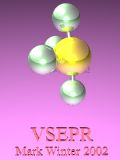 |
|---|
| VSEPR home |
|
|
| The University of Sheffield | |
| Department of Chemistry | VSEPR |
Exercises
Use VSEPR rules to predict the shapes and geometries of the central atoms of the following:
|
|
|
Confirm for which compounds your predicted geometries are correct by referring to appropriate textbooks.
Use the VSEPR rules to predict the coordination geometries of:
- XeF2
- [IF4]-
- SF4
Write down reasonable isomers for your predicted geometries and determine in each case which isomer is the most likely.
Interactive VSEPR calculator
You can use this interactive calculator to check your answers. To show you how the form works it is set up by default to test for SO2Cl2.
 |
|---|
|
|